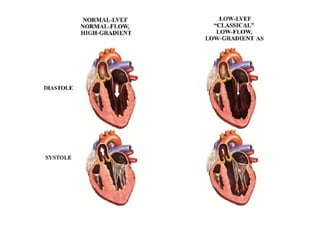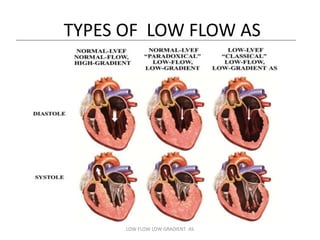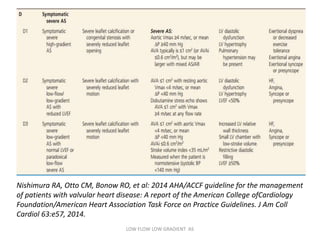low flow low gradient aortic stenosis ppt
LOW FLOW AS DR. DEEP CHANDH RAJA S.

Low Gradient Severe Aortic Stenosis Tctmd Com
Or paradoxical lowflow lowgradient AS demonstrate reduced MEE.
. 1 When a severe AS becomes symptomatic the rate of death is 50 at 2 years unless valve replacement is performed. Development of paradoxical low-flow low-gradient severe aortic stenosis. We discuss current diagnostic and treatment modalities for low-flow low-gradient aortic stenosis.
101136heartjnl-2014-306838 Crossref Medline Google Scholar. The management of these patients can be quite difficult as these patients often show impairment of the left ventricle which can lead to false measurements of the severity of stenosis and also leads to a higher risk during aortic valve. Clinical factors associated with.
True-severe classical and paradoxical low. Crossref Medline Google Scholar. In the Western population prevalence increases exponentially with age resulting in a prevalence of 98 in octogenarians.
Outcome after aortic valve replacement for low-flowlow-gradient aortic stenosis without contractile reserve on dobutamine stress echocardiography. LF LG AS is characterized by combination of severe aortic valve stenosis calculated aortic valve area AVA low transvalvular gradient mean gradient low flow stroke volume 35 mlm 2. However patients with left ventricular ejection fraction.
In patients with aortic stenosis AS a low-flow state may occur with reduced LV ejection fraction LVEF ie classic low flow or with preserved LVEF ie paradoxical low flow and it is often associated with low gradient because the gradient is highly flow-dependent. Low-flow low-gradient aortic stenosis LFLG AS is an echocardiographic entity defined by a mismatch between a reduced aortic valve area AVA 1 cm 2 and a non-severe increase of transvalvular mean pressure gradient MPG 40 mmHg with an impaired stroke volume at rest SV index 35 mlm 2 1 2LFLG AS still puts the clinicians. Curr Opin Cardiol 2007.
AS patients display a persistent ability to maintain normal MVO 2 and MEE ie the ability to convert energy into stroke work. Summary Low-flow low-gradient aortic stenosis is a difficult entity to diagnose and treat. Low-flow low-gradient aortic stenosis.
Various diagnostic modalities are needed to accurately determine the severity of aortic stenosis and potential treatment benefit. When low flow low gradient aortic stenosis is present the challenge is to determine whether the LF-LG AS with. Low-flow low-gradient LF-LG AS is a frequent clinical entity.
Of Patients Mean Age yrs Endpoint MortalityEvent Rates and BenefitofAVR Moderate AS Low-Gradient AS High-Gradient AS Group With The Highest Mortality NFLG LFLG NFHG LFHG Event Rate. Peak V 27 ms Mean Gr 30 mmHg AVA 07 cm2 LVOT TVI 16 cm SV 45 ml. With this hemodynamic presentation it is difficult to distinguish true aortic valve stenosis where the primary Author.
These findings suggest that mitochondrial uncoupling contributes. However as many as 30 of patients who have a calculated AVA in the severe range have other parameters suggesting mild or moderate disease ie mean gradient low-flowlow-gradient AS LFLGAS may truly have severe AS with resultant myocardial failure true AS or may have more moderate degrees of AS and. In the Western population prevalence increases exponentially with age resulting in a prevalence of 98 in octogenarians.
Her history was. Valvular aortic stenosis AS is the most frequently observed valvular heart disease. From evaluation to treatment.
Aortic stenosis is the 3 rd most common CV disease after HTN and CAD in western world Prevalence is 2-7 over the age of 65 years Evaluation of aortic stenosis is the most challenging of all valvular heart diseases Stewart BF Siscovick D Lind BK et al. Aortic valve is composed of three cusps of equal size each of which is surrounded by a sinus Cusps are separated by three commissures and supported by a fibrous anulus Each cusp is crescent shaped and capable of opening fully to allow unimpeded forward flow then closing tightly to prevent regurgitation. A small aortic valve area AVA.
An aortic valve areas 10 cm 2 and. This article summarizes current guidelines and best practices for the management of. Valvular aortic stenosis AS is the most frequently observed valvular heart disease.
Article summarizes current guidelines and best practices for the management of low-flow low-gradient aortic stenosis. This unique indicator is now part of the history. JACC 2014 In Normal or High flow Conditions SV 35 mLm2 Low Flow Low EF Severe AS Is It.
Mean gradient 25 mmHg 25 40 40 mmHg Valve area 15 cm2 10 15 10 cm2 Aortic Stenosis AHA ACC Guidelines Nishimura R. Global longitudinal strain greater than 12. Blackouts and dizziness on and off for several weeks.
A mean pressure difference or gradient across the aortic valve of 40 mm Hg. She also had a low-grade continuous fever without any chills or rigors. Classification of Aortic Stenosis Severity Mean gradient mm Hg Aortic valve area cm2 Mild 25 15 Moderate 25-40 1-15 Severe 40 1 or 05 cm2m2 body surface area Critical 80 05.
A left ventricular ejection fraction 40-50 30 in other references and. In the past the unique accepted indicator for aortic valve replacement AVR in the presence of AS was a mean transvalvular gradient MTG 40 mmHg peak aortic velocity V max 4 ms and aortic valve area AVA 1 cm 2 with accompanying symptoms. Many patients with severe aortic stenosis have a low-flow low-gradient aortic stenosis.
The severity of low-flow low-gradient aortic stenosis cases continue to be misunderstood because of challenging diagnosis and treatment remains complex. LF-LG AS with low LVEF is defined as. Systemic hypertension in low-gradient severe aortic stenosis with preserved ejection fraction.
1 When a severe AS becomes symptomatic the rate of death is 50 at 2 years unless valve replacement is performed. 228491 Clavel MA Webb JG Rodés-Cabau J et al. Comparison between transcatheter and surgical prosthetic valve implantation in patients with severe aortic stenosis and reduced left ventricular ejection fraction.
J Am Coll Cardiol. An important proportion of patients with aortic stenosis AS have a low-gradient AS ie. TABLE 1 Outcome and Impact of Aortic Valve Replacement in Patients With Aortic Stenosis According to the FlowGradient Category First Author Year Ref.
Eleid MF Nishimura RA Sorajja P Borlaug BA.

Resolving Apparent Inconsistencies Between Area Flow And Gradient Measurements In Patients With Aortic Valve Stenosis And Preserved Left Ventricular Ejection Fraction American Journal Of Cardiology

Low Flow Low Gradient Aortic Stenosis When Is It Severe American College Of Cardiology

Low Flow Aortic Stenosis Latest Explanations

Outcome Of Flow Gradient Patterns Of Aortic Stenosis After Aortic Valve Replacement Circulation Cardiovascular Interventions

Low Flow Low Gradient Aortic Stenosis

Simplifying The Approach To Classical Low Flow Low Gradient Severe Aortic Stenosis A Renewed Emphasis On The Resting Transthoracic Echocardiogram International Journal Of Cardiology

Paradoxical Low Flow And Or Low Gradient Severe Aortic Stenosis Despite Preserved Left Ventricular Ejection Fraction Implications For Diagnosis And Treatment Ppt Download

Progression Of Normal Flow Low Gradient Severe Aortic Stenosis With Preserved Left Ventricular Ejection Fraction American Journal Of Cardiology

A Clinical Algorithm For Diagnosing And Managing Patients With Low Flow Low Gradient Aortic Stenosis Tctmd Com

Low Flow Low Gradient Aortic Stenosis

Low Flow Low Gradient Aortic Stenosis

Severe Aortic Stenosis And Tavr Ppt Video Online Download

Impact Of Left Ventricular Dysfunction In Patients With High And Low Gradient Severe Aortic Stenosis Following Transcatheter Aortic Valve Replacement Canadian Journal Of Cardiology

Signs Of Late Stage Vavular Heart Disease Valvular Heart Disease Assessment Of Lesion Severity Valvular Heart Disease Disease

Flow Rate In Aortic Stenosis Clinical Tool Hemodynamic Insight Or Both Journal Of The American Society Of Echocardiography